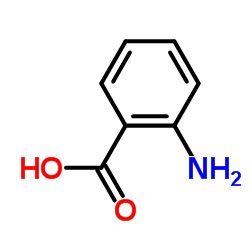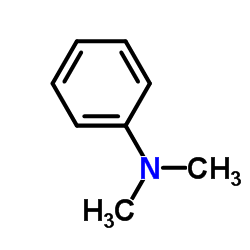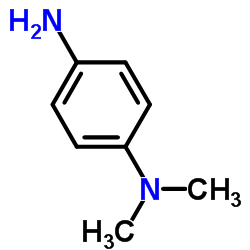493-52-7
| 中文名 | 甲基红 |
|---|---|
| 英文名 | methyl red |
| 中文别名 |
甲基
酸性红 2 |
| 英文别名 |
2-[4-(dimethylamino)phenylazo]benzoic acid
2-[[4-(dimethylamino)phenyl]diazenyl]benzoic acid O-METHYL RED EINECS 207-776-1 Methyl Red,indicator p-(Dimethylamino)azobenzene-o-carboxylic acid Benzoic acid, 2-[(E)-2-[4-(dimethylamino)phenyl]diazenyl]- Hydrazine sulfate C.I. Acid Red 2 2-(4-Dimethylaminophenylazo)benzoic acid 2-[[4-(Dimethylamino)phenyl]azo]benzoic Acid 4-Dimethylaminoazobenzene-2'-carboxylic acid Methyl Red Acid Red 2 2-{(E)-[4-(Dimethylamino)phenyl]diazenyl}benzoic acid 4'-dimethylaminoazobenzene-2-carboxylic acid 4-Dimethylamino-2'-carboxylazobenzene MFCD00002425 2-Carboxy-4'-(dimethylamino)azobenzene |
| 密度 | 1.2±0.1 g/cm3 |
|---|---|
| 沸点 | 479.5±30.0 °C at 760 mmHg |
| 熔点 | 178-182ºC |
| 分子式 | C15H15N3O2 |
| 分子量 | 269.298 |
| 闪点 | 243.8±24.6 °C |
| 精确质量 | 269.116425 |
| PSA | 65.26000 |
| LogP | 4.91 |
| 外观性状 | 暗红色结晶粉末 |
| 蒸汽压 | 0.0±1.3 mmHg at 25°C |
| 折射率 | 1.593 |
| 储存条件 | -20密封保存,放置在通风,干燥的环境中 |
| 稳定性 | 1.按规格使用和贮存,不会发生分解,避免与氧化物接触。 |
| 水溶解性 | ethanol: soluble1mg/mL |
| 计算化学 | 1.疏水参数计算参考值(XlogP):3.3 2.氢键供体数量:1 3.氢键受体数量:5 4.可旋转化学键数量:4 5.互变异构体数量:无 6.拓扑分子极性表面积65.3 7.重原子数量:20 8.表面电荷:0 9.复杂度:349 10.同位素原子数量:0 11.确定原子立构中心数量:0 12.不确定原子立构中心数量:0 13.确定化学键立构中心数量:0 14.不确定化学键立构中心数量:0 15.共价键单元数量:1 |
| 更多 | 1. 性状:有光泽的紫色结晶或红棕色粉末 2. 密度(g/ m3,25/4℃):0.839 3. 相对蒸汽密度(g/cm3,空气=1):未确定 4. 熔点(ºC):178-182 5. 沸点(ºC,常压):未确定 6. 沸点(ºC,5.2kPa):未确定 7. 折射率:未确定 8. 闪点(ºF):11 9. 比旋光度(º):未确定 10. 自燃点或引燃温度(ºC):未确定 11. 蒸气压(kPa,25ºC):未确定 12. 饱和蒸气压(kPa,60ºC):未确定 13. 燃烧热(KJ/mol):未确定 14. 临界温度(ºC):未确定 15. 临界压力(KPa):未确定 16. 油水(辛醇/水)分配系数的对数值:未确定 17. 爆炸上限(%,V/V):未确定 18. 爆炸下限(%,V/V):未确定 19. 溶解性:微溶于水,溶于乙醇及乙酸,其酸溶液随时间的增长因羧基酯化而使变色灵敏度下降。 |
Synonym:C.I. Acid Red 2; 2-(4-Dimethylaminophenylazo)benzoic acid; C.I. 13020; p-(Dimethylamino)azobenzene-o-carboxylic acid; Methyl Red Section 2 - COMPOSITION, INFORMATION ON INGREDIENTS
Risk Phrases: None Listed. Section 3 - HAZARDS IDENTIFICATION EMERGENCY OVERVIEW
Not available. Potential Health Effects Eye: Contact may cause transient eye irritation. This product contains an anionic dye. Similar dyes have not caused injury to the cornea or conjunctiva in documented exposure cases with human or rabbit eyes. Skin: May cause skin irritation. Ingestion: May cause irritation of the digestive tract. The toxicological properties of this substance have not been fully investigated. Inhalation: May cause respiratory tract irritation. The toxicological properties of this substance have not been fully investigated. Chronic: Chronic exposure may cause liver damage. Section 4 - FIRST AID MEASURES Eyes: In case of contact, immediately flush eyes with plenty of water for at least 15 minutes. Get medical aid. Skin: In case of contact, flush skin with plenty of water. Remove contaminated clothing and shoes. Get medical aid if irritation develops and persists. Wash clothing before reuse. Ingestion: If swallowed, do not induce vomiting unless directed to do so by medical personnel. Never give anything by mouth to an unconscious person. Get medical aid. Inhalation: If inhaled, remove to fresh air. If not breathing, give artificial respiration. If breathing is difficult, give oxygen. Get medical aid. Notes to Physician: Section 5 - FIRE FIGHTING MEASURES General Information: As in any fire, wear a self-contained breathing apparatus in pressure-demand, MSHA/NIOSH (approved or equivalent), and full protective gear. Combustion generates toxic fumes. This material in sufficient quantity and reduced particle size is capable of creating a dust explosion. Extinguishing Media: For small fires, use water spray, dry chemical, carbon dioxide or chemical foam. Section 6 - ACCIDENTAL RELEASE MEASURES General Information: Use proper personal protective equipment as indicated in Section 8. Spills/Leaks: Clean up spills immediately, observing precautions in the Protective Equipment section. Sweep up, then place into a suitable container for disposal. Avoid generating dusty conditions. Provide ventilation. Section 7 - HANDLING and STORAGE Handling: Wash thoroughly after handling. Use with adequate ventilation. Minimize dust generation and accumulation. Avoid contact with eyes, skin, and clothing. Avoid ingestion and inhalation. Storage: Store in a cool, dry, well-ventilated area away from incompatible substances. Section 8 - EXPOSURE CONTROLS, PERSONAL PROTECTION Engineering Controls: Facilities storing or utilizing this material should be equipped with an eyewash facility and a safety shower. Use adequate ventilation to keep airborne concentrations low. Exposure Limits CAS# 493-52-7: Personal Protective Equipment Eyes: Wear appropriate protective eyeglasses or chemical safety goggles as described by OSHA's eye and face protection regulations in 29 CFR 1910.133 or European Standard EN166. Skin: Wear appropriate protective gloves to prevent skin exposure. Clothing: Wear appropriate protective clothing to minimize contact with skin. Respirators: Follow the OSHA respirator regulations found in 29 CFR 1910.134 or European Standard EN 149. Use a NIOSH/MSHA or European Standard EN 149 approved respirator if exposure limits are exceeded or if irritation or other symptoms are experienced. Section 9 - PHYSICAL AND CHEMICAL PROPERTIES Physical State: Solid Color: dark red to purple Odor: none reported pH: Not available. Vapor Pressure: Negliglble. Viscosity: Not available. Boiling Point: Not available. Freezing/Melting Point: 179-182 deg C Autoignition Temperature: Not applicable. Flash Point: Not applicable. Explosion Limits, lower: Not available. Explosion Limits, upper: Not available. Decomposition Temperature: Not available. Solubility in water: Insoluble in water. Specific Gravity/Density: Not available. Molecular Formula: C15H15N3O2 Molecular Weight: 269.30 Section 10 - STABILITY AND REACTIVITY Chemical Stability: Stable under normal temperatures and pressures. Materials containing similar functional groups can decompose at elevated temperatures. Conditions to Avoid: Dust generation, excess heat. Incompatibilities with Other Materials: Strong oxidizing agents. Hazardous Decomposition Products: Nitrogen oxides, carbon monoxide, carbon dioxide. Hazardous Polymerization: Has not been reported. Section 11 - TOXICOLOGICAL INFORMATION RTECS#: CAS# 493-52-7: DG8960000 LD50/LC50: Not available. Carcinogenicity: Methyl Red - Not listed by ACGIH, IARC, or NTP. Other: See actual entry in RTECS for complete information. Section 12 - ECOLOGICAL INFORMATION Section 13 - DISPOSAL CONSIDERATIONS Dispose of in a manner consistent with federal, state, and local regulations. Section 14 - TRANSPORT INFORMATION IATA Shipping Name: Not regulated. Hazard Class: UN Number: Packing Group: IMO Shipping Name: Not regulated. Hazard Class: UN Number: Packing Group: RID/ADR Shipping Name: Not regulated. Hazard Class: UN Number: Packing group: Section 15 - REGULATORY INFORMATION European/International Regulations European Labeling in Accordance with EC Directives Hazard Symbols: Not available. Risk Phrases: Safety Phrases: S 24/25 Avoid contact with skin and eyes. WGK (Water Danger/Protection) CAS# 493-52-7: 2 Canada CAS# 493-52-7 is listed on Canada's DSL List. CAS# 493-52-7 is not listed on Canada's Ingredient Disclosure List. US FEDERAL TSCA CAS# 493-52-7 is listed on the TSCA inventory. SECTION 16 - ADDITIONAL INFORMATION N/A |
|
毒理学数据: 1、致肿瘤数据:小鼠经口TDLo:12 gm/kg/57W-C,RTECS标准,肝-肿瘤; 2、致突变数据:微生物机体TEST系统突变:细菌-鼠伤寒沙门氏杆菌:50ug/plate; DNA的repairTEST系统:细菌-枯草芽孢杆菌:2 mg/disc; 非程序DNA synthesisTEST系统:啮齿动物-鼠肝:10umol/L 生态学数据: 该物质对环境可能有危害,对水体应给予特别注意。 CHEMICAL IDENTIFICATION
HEALTH HAZARD DATAACUTE TOXICITY DATA
MUTATION DATA
|
| 符号 |

GHS07 |
|---|---|
| 信号词 | Warning |
| 危害声明 | H319 |
| 警示性声明 | P280-P305 + P351 + P338-P337 + P313 |
| 个人防护装备 | Eyeshields;full-face respirator (US);Gloves;multi-purpose combination respirator cartridge (US);type ABEK (EN14387) respirator filter |
| 危害码 (欧洲) | Xn:Harmful; |
| 风险声明 (欧洲) | R10;R20/21/22;R68 |
| 安全声明 (欧洲) | S36/37 |
| 危险品运输编码 | UN 1170 |
| WGK德国 | 1 |
| RTECS号 | DG8960000 |
| 海关编码 | 29270000 |
|
~% 
493-52-7 |
| 文献:Rupp; Loose Chemische Berichte, 1908 , vol. 41, p. 3906 |
|
~% 
493-52-7 |
| 文献:Rupp Archiv der Pharmazie (Weinheim, Germany), 1915 , vol. 253, p. 372 Full Text Show Details Tizard Journal of the Chemical Society, 1910 , vol. 97, p. 2487 Full Text Show Details Schorger Industrial and Engineering Chemistry, 1923 , vol. 15, p. 742 Chem. Zentralbl., 1923 , vol. 94, # IV p. 933 Full Text Show Details Merck Patent: DE409282 ; Fortschr. Teerfarbenfabr. Verw. Industriezweige, vol. 14, p. 955 |
| 上游产品 3 | |
|---|---|
| 下游产品 2 | |
| 海关编码 | 2927000090 |
|---|---|
| 中文概述 | 2927000090 其他重氮化合物、偶氮化合物等(包括氧化偶氮化合物). 增值税率:17.0% 退税率:9.0% 监管条件:无 最惠国关税:6.5% 普通关税:30.0% |
| 申报要素 | 品名, 成分含量, 用途 |
| Summary | 2927000090 other diazo-, azo- or azoxy-compounds。Supervision conditions:None。VAT:17.0%。Tax rebate rate:9.0%。MFN tariff:6.5%。General tariff:30.0% |








